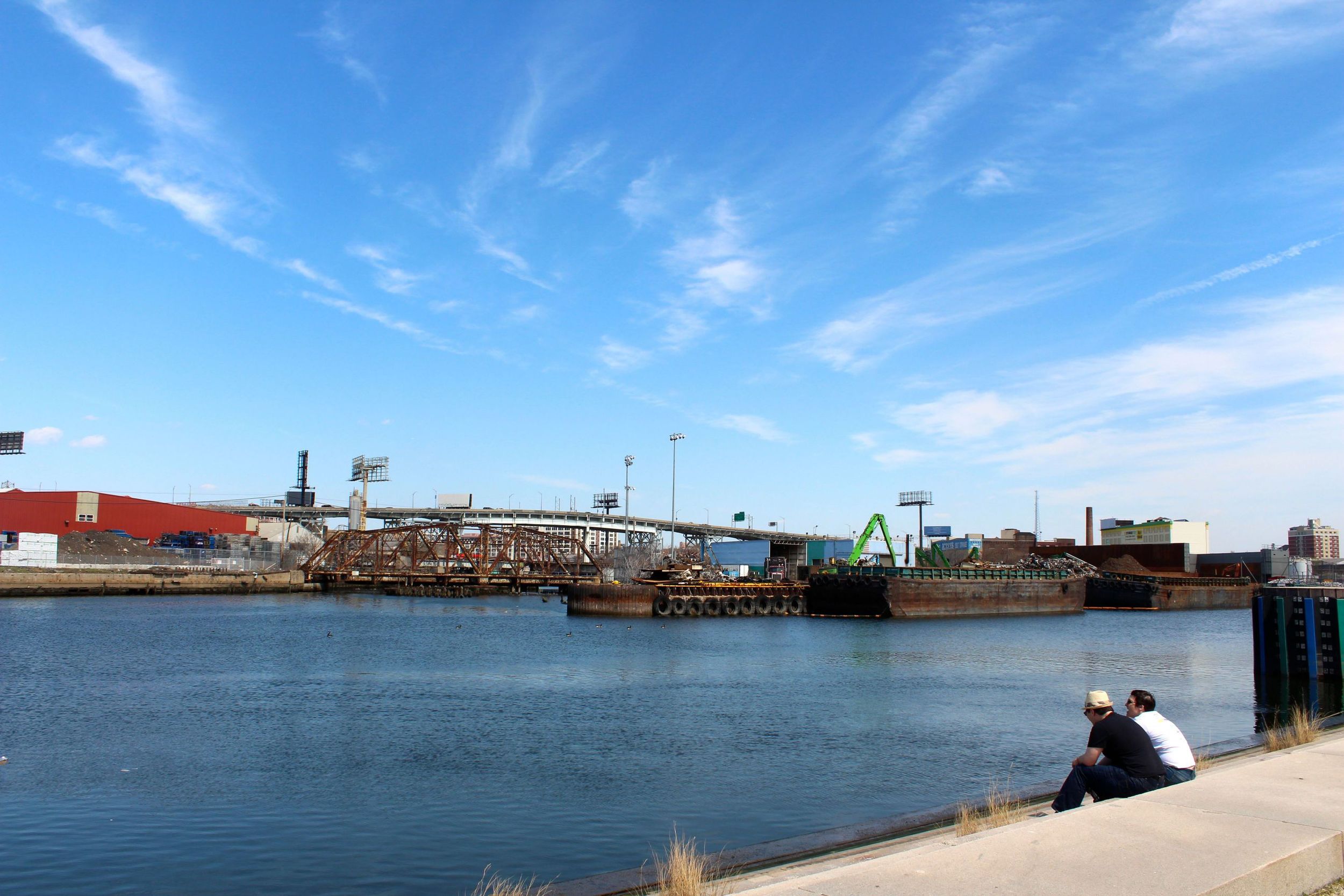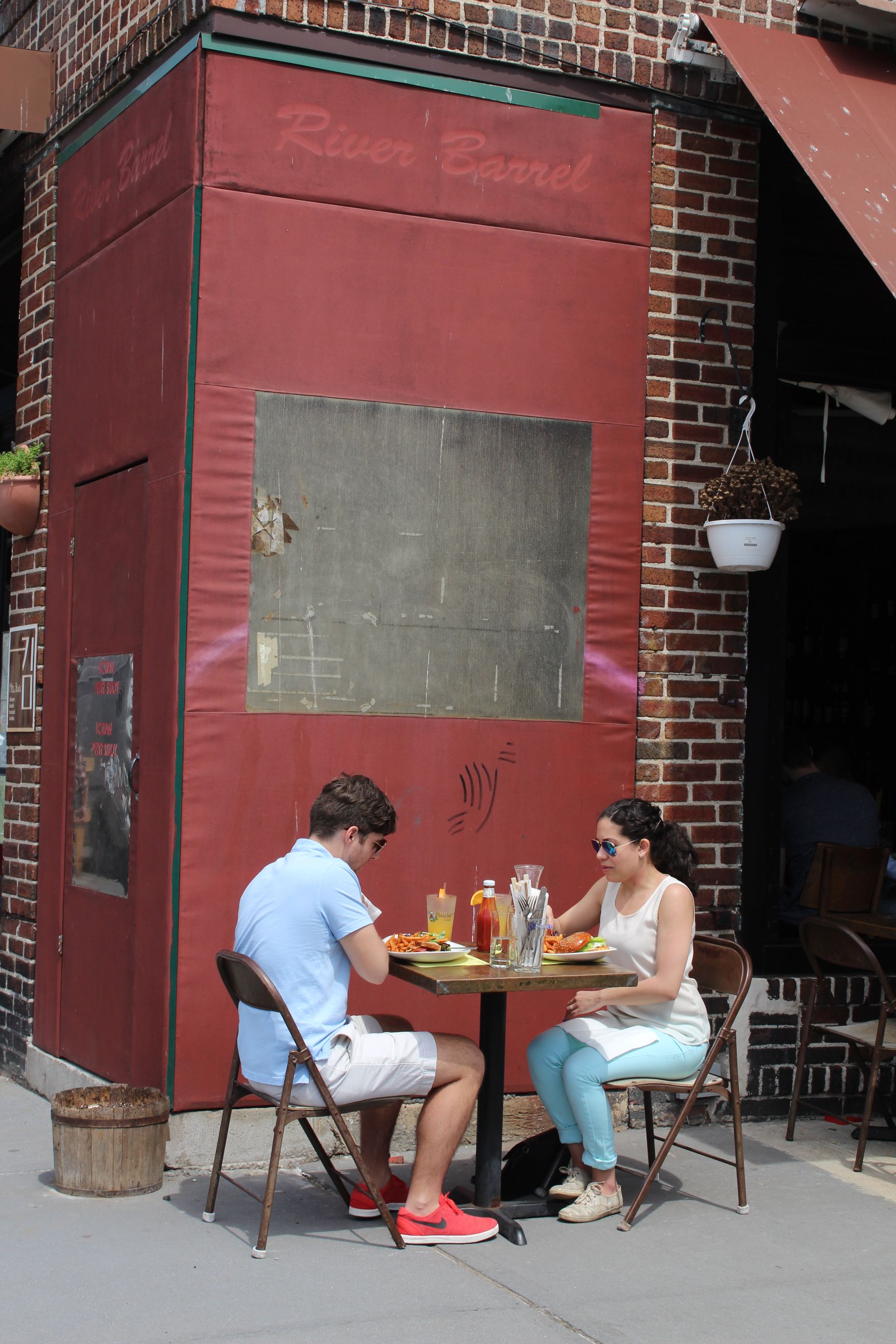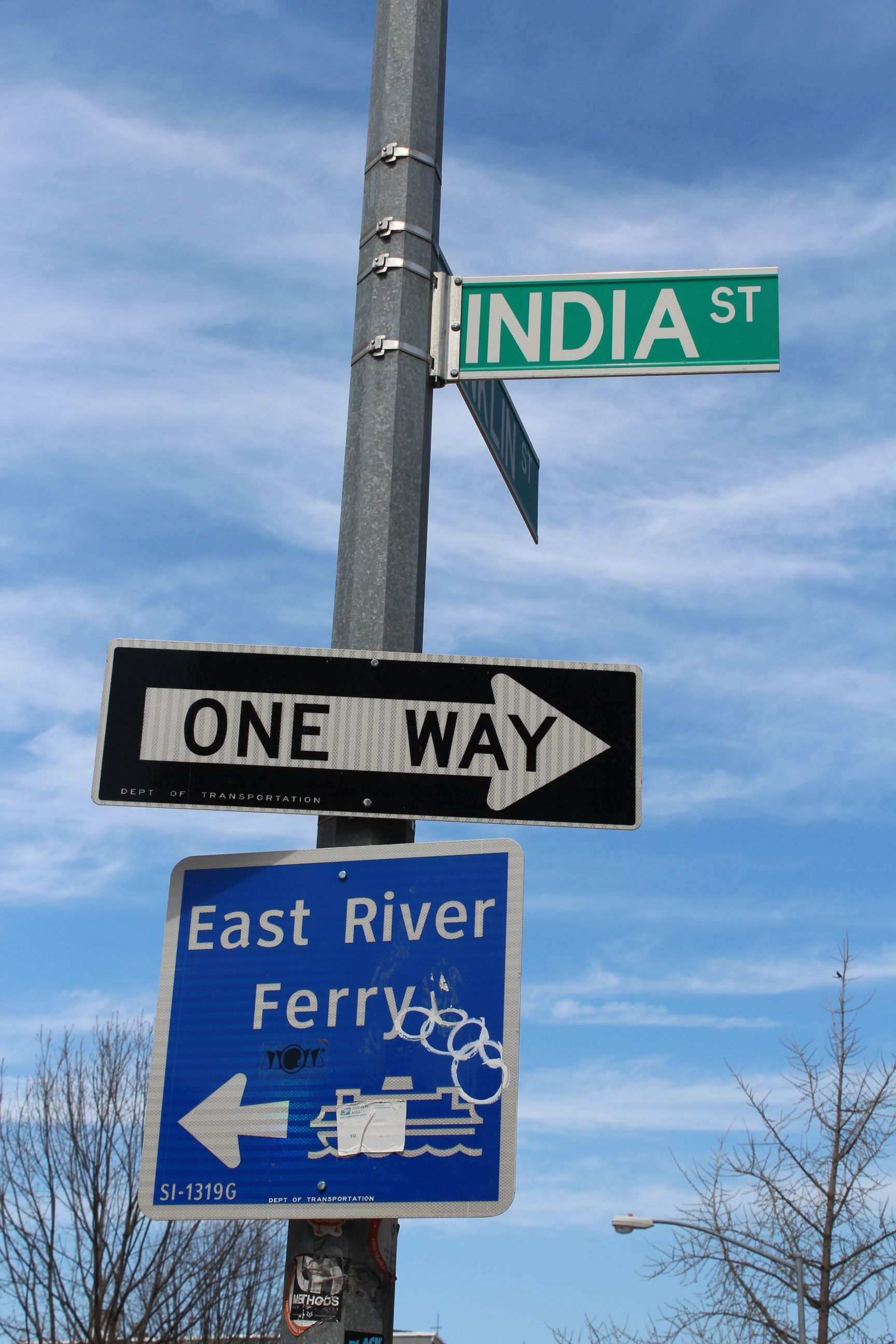Prologue
If you knew nothing about this part of the NY coastline, what would you see as you walked its waterfront?
beauty



or
the beast



This trip is an exercise in seeing the world around us. Greenpoint is certainly not the only part of our waterfront to present conflicting stories, but it is a microcosm of the city's coastal areas as a whole; of our natural resources and the history and economic forces which drive our shoreline's development.
“‘You see, but you do not observe. The distinction is clear.’
”
We hear but we do not always listen...the warnings and environmental issues at play in Greenpoint are not new ones. Take a moment to watch this educational/ecological piece of performance art, done in 2008 by Eve Mosher, four years prior to Hurricane Sandy in 2012. Did we pay attention to the warnings then? Have we listened or acted in the post-Sandy era?
REFLECTION: Prior to setting out on this trip, take a moment to consider the 3 issues listed below. As members of the greater NYC community, the majority of us are informed adults and have opinions about the following topics:
- #1 - Do we learn from our mistakes post Hurricane Sandy - creative solutions
#2 - what every NYC citizen should know...basic environmental and economic history of NYC costal areas
#3 - what aesthetics and moral imperatives should be taken into account during waterfront development - consider your own personal sensibilities
Now Visually compare today's coastline with New York in 1609 on this interactive map created by the Wildlife Conservation society. This site allows you to compare the original ecology of our region with that of the current day. 'Click' to begin, and then zoom in on the Greenpoint area. Slide the 'past/present' control located at the bottom of the screen to see how we have changed our coastlines over time. You will be shocked at the difference!
Travelogue
Pack & Prepare
- bring a mobile device with internet capability in order to capture images and use the trip's interactive links and maps
- purchase on-line ferry tickets ahead of time from the East River Ferry website. An all day tix is $12 and will get you to and from Manhattan, Queens & Brooklyn. This is cheaper than purchasing each ticket individually. Store them on your device. (It is also possible to purchase tix at machines located on each terminal pier)
- wear comfortable walking shoes.
- be mindful of the 3 reflection topics while walking today
- Trip length: 4 miles, approx 3-4 hours.
1. the river







- East River Ferry Mid Town Terminal to Hunter's Point South Ferry Terminal (35th Street & FDR to HPSouth Park, between 54th & Borden Avenues).
What better way to study the coastline than from aboard a ferry boat. Purchase your ticket ahead of time, and take the 5 min ride over to Queens to begin your day. You will be arriving at the beautiful Hunter's Point South Park. This highly landscaped development site is close to completion and will include apartment towers, shops and redesigned public spaces. 93,000 people applied to live in these new residential units and the old industrial ruins and natural shoreline are disappearing. Enjoy the view of Manhattan, and then make your way up Center Blvd to 49 street and head east until you reach the bridge.
2. the bridge
- Pulaski Bridge (connects Long Island City, Queens to Greenpoint, Brooklyn - access to pedestrian walkway of bridge at the intersection of 49th St, 11th St., & Jackson Ave) Walk from Queens to Brooklyn over Newtown Creek. Newtown is the first of two smaller waterways feeding into the East River which we will examine today. The bridge affords you a unique ariel perspective of the creek and the world that surrounds it. What industries do you observe which come into direct contact with the water? Like so many things on this walk there is great beauty here, and there is also extreme deterioration. Begin a running list in your head of both the beautiful and the contaminated places that you see in Greenpoint.









3. The creek
- Newtown Creek Nature Walk (Paidge Avenue, Brooklyn) Cross under the bridge and walk east on Paidge Avenue to the intersection with Provost Street where you will see a small triangular piece of land on the corner with two boulders marking the beginning of this 1/4 mile walk. As you walk down the remainder of the street, make sure to read all of the labels and art work which have been carefully designed to highlight the area's past. Enter through the gates at the end of Paidge and follow the walk east along the Creek. Consult the walk's brochure (see the link above for details) and follow the bend in the walk to Whale Creek. As you follow the path to its end, you will see the Newtown Creek Wastewater Treatment Plant rising up to your left across the water. Planned by a team of community leaders, architects and environmental engineering consultants, the plant has received awards from the New York City Art Commission for Excellence in Design and lighting artist Hervé Descottes of L'Obervatoire International created its nighttime illumination effects.The dramatic 'Digester Eggs' are a focal point of the site and underscore important precepts of 21st century urban planning. Alec Applebaum, who teaches at Pratt Institute & is a spokesman for New Yorkers for Parks states that society is beginning to look at how public works and architecture intersect. "Infrastructure is designed to be seen and not hidden." states Applebaum. "During the 20th century, cities were organized and built on a premise of abundance and we are learning that this world view this is no longer viable. In today's society, we must begin to deal with our limitations." Ponder these words as you return to the Pulaski Bridge. Keep adding to your internal list of positives and negatives contemplating how nature and the city co-exist today.










4. the northern shoreline
- Box House Hotel (77 Box St.) Once a door factory, this hotel sits practically underneath the Pulaski Bridge and is about as 'gritty urban chic' as it gets. Throughout our walk we will be looking at architectural repurposing rather than demolishing of old industrial sites. Perhaps this site is too industrial for you. It has an attractive lobby, however, and its unusual location in this up and coming neighborhood, makes it a perfect example of how the manufacturing-based economics of the neighborhood have begun to convert to a tourism-based model.
- Greenpoint Manufacturing and Design Center (1205 Manhattan Avenue, #211) Another example of creative renovation. This old warehouse provides workspace for artists and designers. It sits at the end of Manhattan Avenue, near a small creek-side park and a dramatic sculpture wall which showcases three arresting nude figures.
- Ashbox Café (1154 Manhattan Avenue) This small cafe gets its name from its location between Ash and Box streets. This tiny establishment's relaxed, sunny interior make it a wonderful refreshment stop. Its tea selection is superb and it serves a interesting mixture of Japanese and American dishes.
- Run along the same route that Adam & Hannah go jogging on in HBO's hit show 'Girls' (Commercial Street to Newport Barge Playground)
- Newtown Barge Park (Commercial & Dupont Streets) Next to a playground, this rather deteriorated corner of the coastline will be soon be converted into a park. Construction will begin here in early 2016.








5. franklin avenue: the changing face of greenpoint
Once you reach the shoreline, turn south and walk down Franklin Avenue until you reach Bushwick Inlet. Compared to its eastern twin Manhattan Avenue, this commercial street now is a showcase for many small hip businesses. Some locals resent the gentrification, and others appreciate it. Browse for designer clothes at Alter Vintage Clothing, for books at Word, and scope out cool antiques & housewares at Le Grenier. You can even stop for a snack at Anella Restaurant, a local favorite, just make sure you save some space for your main meal later on in the trip.








'Artists are always the Johnny Appleseeds of gentrification'
- Scott Hutchins, 'A Working Theory of Love'
Do not forget to enjoy and observe. This is a neighborhood on the edge of many changes. Keep listing those pros and cons.
6. The Battle of Bushwick
You have now reached the southernmost part of our walk; Bushwick Inlet. This old industrial waterfront was re-zoned in 2005 as residential land, with a promised 28-acre public park planned along the river.
'Some of the anticipated buildings and residents have materialized, but most of the parkland has not. A soccer field is already in use, and a park building and playground are under construction. But the city has only just started a multiyear deal to acquire a site that houses an oil depot, and has no budget or timetable to clean it up or to buy another major parcel already designated as parkland...'
-Diane Cardwell, 'Tower has Its Own Lawn, but Neighbors Still Look for For Their Open Space' , New York Times
In February of 2015, a warehouse fire located on one of the two industrial slips still in use awakened renewed debate about the possible future use of this land. Park land, commercial property or residential construction...what would you do? What would be best for this devastated and embattled stretch of land?




7. Take to the rooftops
After inspecting the Inlet, take a moment to reflect & make your own plan for future neighborhood development over a delicious meal. If you time your walk correctly, you will have time to have a late lunch/early dinner and still make the ferry home.
- Northern Territory (12 Franklin St) Although the rooftop of this Australian-themed restaurant does not accept reservations, it makes for a stunning place to reconnoiter and debate the topics of the day. NT is open at 11am on weekends, and at 5pm from M-Fri. Offering small plates as well as Australian specialties such as meat pies and "fish in foil", the restaurant provides a dramatic backdrop for a discussion of the walk's three reflection points.
- Dirck The Norseman (7 N. 15th Street & corner of Franklin) If you'd prefer to remain at street level, this Brooklyn Brewery is another dining option. Offering 16 varieties of beer and traditional european cuisine, You can look right out onto the Inlet as you ponder the issues raised by today's trip. Take your pick of venue, but enjoy a good meal prior to...
8. heading back home - the india street ferry
Walk up towards the India Street East River Ferry Terminal, via West Street. Check out the gorgeous Indonesian woods at furniture store 'From the Source' and make a stop at 'WNYC Transmitter Park' . This park is one of the few pieces of waterfront which has become a public park. West Street is an ideal opportunity to inspect construction and building which is taking place along the shoreline. As you walk, look carefully at the zoning notification signs on construction sites and keep tabs on each venture's designated classification; commercial, residential, etc. Notice where the sites are located in terms of the high water lines. Is Greenpoint succeeding at taking back its coastline & addressing climate and environmental concerns? This stretch of land is in flux...its an opportunity...but for whom, exactly?









History lies around you, in the street names as you pass; Huron, Java and finally up to India, where the return ferry awaits your pleasure. As you cross the river back towards Manhattan watch the coastline recede into the distance. From your vantage point on board, you can easily see the shoreline with its new waterfront buildings, the remains of its tattered natural coastline....and its incredible flawed beauty.







Epilogue
quiz yourself...
(& then check your answers below each question)
question #1
What do the dates 1870, 1978 and 2010 have in common and how do they relate to the Greenpoint neighborhood?
1840s - At this time Greenpoint area was already home to oil refineries & petroleum processing plants. By the 1870s alone, there were 50 plants functioning in the area. Overall environmental damage is the result of 140 years of systematic pollution.
1978 - An oil plume was spotted by a US Coastguard pilot flying over Newtown Creek. It was found to contain between 17-30 million gallons - at least 50% bigger than the Exxon-Valdez spill in 1989. Due to the scope of this problem, cleaning up the area will inevitably be slow and requires constant participation by community members.
2010 - Area was declared a Superfund Site (see above image) and Attorney General Andrew Cuomo announced a settlement with ExxonMobil requiring them to pay for clean-up, investigate contamination and establish a $19.5 million dollar 'Environmental Benefits Project Fund' to benefit the area.
question #2
Once our human waste enters the sewage system, is any part of it re-used? How?
Filmed at the beautiful Newtown Creek Wastewater Treatment Facility, this 23 minute film provides the answer to our question and raises some valuable questions about infrastructure and our ability to accept the consequences of our accions.
question #3
How many of the many waterfront redesign initiatives initially discussed (Post-Hurricane Sandy) have been built or are actively being pursued at this time?
Only a few of the smallest projects initially proposed have been finished. Read the NYT 9/2014 summary of our work thus far in the article 'Building for the Next Storm'.
question #4
Based on your walking tour, what is the majority of the Greenpoint coastline currently being re-zoned for; park land/public spaces? for commercial use? for residential use? for industrial use? Does this construction appear to be zoned in a way to prevent future environmental problems when the next Super-Storm comes our way? see images below
Re-Zoning, Eminent Domain, Public Development, & Civic Entropy. Read this NYT article about the fight for Bushwick Park.
Did you score high marks on the quiz? Would your initial perception of this neighborhood have been different if you had known this information prior to taking the trip? Knowledge allow us to see beyond the surface of things. How would you increase community involvement in issues such as environmental stewardship and ethical redevelopment of our waterways?
Food For Thought...
BEAUTY THE BEAST
How would you define Beauty and The Beast, in terms of some of the issues we have examined on this walk?













